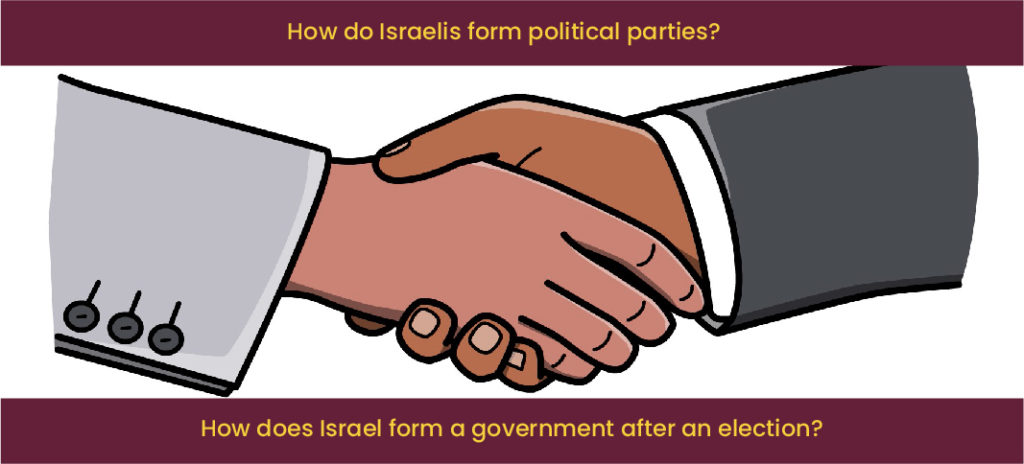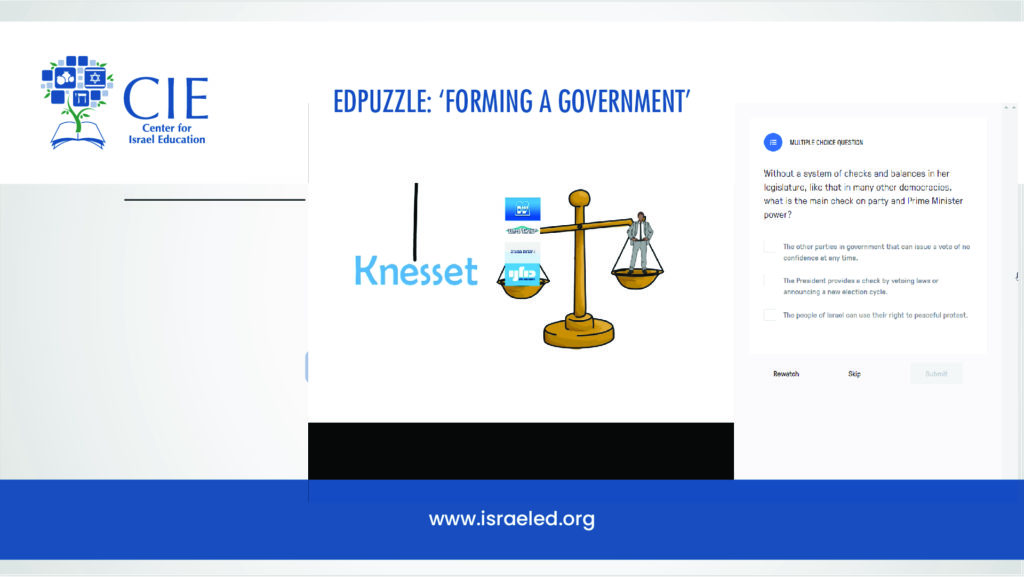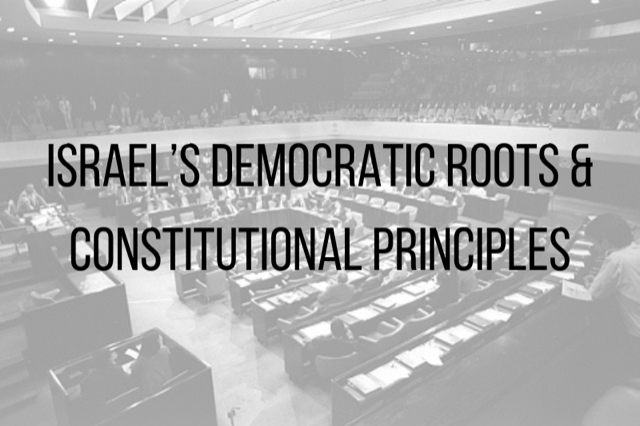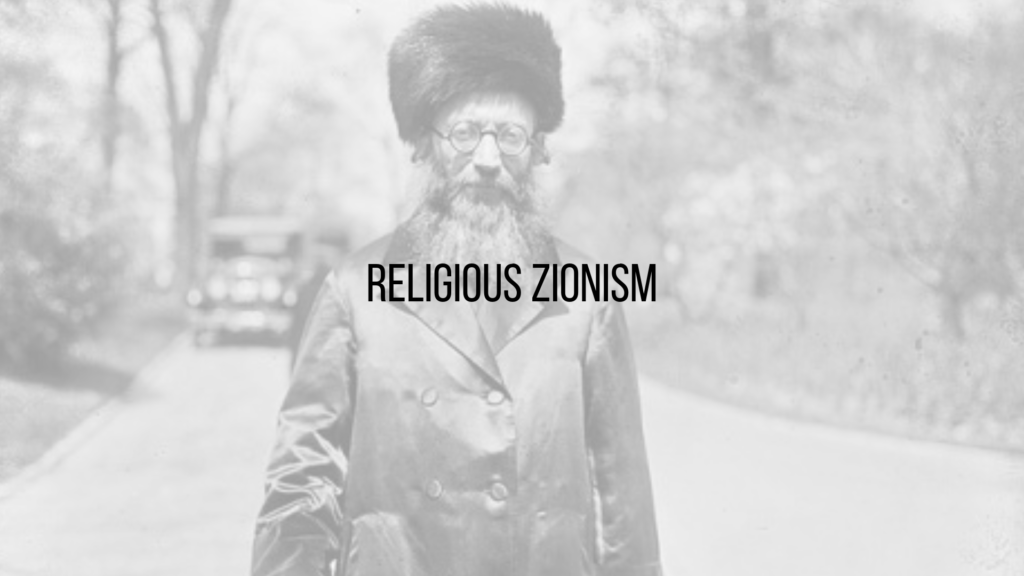Elections, Parliament, Political Culture, Prime Ministers, Parties and the Voting Public
Israel has a parliamentary system of government with some unusual features in the elections and the creation of multiparty ruling coalitions, as explained by the Ministry of Foreign Affairs. Click here to see the results of all of the elections with infographics for Israel’s parliament, known as the Knesset, and the people who have served as prime minister. We have assembled two broad elements for learning and teaching about this election system:
A) We have posed nine broad guiding questions, with some answers provided and suggested links to read more, see a video, and provision of valuable analyses collated monthly in our Contemporary Readings, where we suggest using Control + F to search for “elections” or “parliament” to find relevant articles.
B) We provide specific resources for four specific age groups. We realize that some materials are not too advanced for some. These are CIE resources with age-group-appropriate categories:
1. Introductory, sixth- to eighth-graders.
2. Intermediate, high-schoolers.
3. Advanced, college students.
4. Above Advanced, post-college adults.
These materials can help answer the following key questions that promote understanding:
1. What are the sources of Israel as a democracy? How did the growing Jewish presence in Palestine between the world wars develop the institutions to support elected, representative government?
2. Why does Israel use a parliamentary system and not a presidential system, more like the United Kingdom than the United States?
3. How do Israelis form political parties? What are party lists, and how are they created? How many parties contest parliamentary elections?
4. How do issues of religion and state influence politics? How do Israel’s most observant Jews relate to the State of Israel? What role do religiously motivated parties play in Israeli elections and governments?
5. How do Israel’s non-Jewish citizens, who make up more than 20% of the population, participate in its elections and its self-determination process? What part do Israel’s Arab and Druze citizens play in the Knesset and the government?
6. What do polls and surveys tell us about Israeli political preferences, and how have those preferences shifted between left and right over time? What do left and right mean in the Israeli context?
7. How does Israel elect its parliament, known as the Knesset? What laws, processes and procedures come into play before, during and after Election Day? How do the vote totals turn into the 120 seats in the Knesset? How does the Israeli parliamentary election differ from those in the United Kingdom and Canada?
8. How does Israel form a government after an election? What is a coalition government, and why does Israel always have one? How is the prime minister chosen?
9. Why do Israeli governments fall and force elections more often than the required once every four years? Why has Israel repeatedly held elections since 2019?
We indicate with each resource our suggestions for which of the questions it can help answer.
Introductory
This whiteboard video, revised for the Nov. 1, 2022, Knesset election, explains the use of party lists, proportional representation, and a single, nationwide electoral district. Length: 4 minutes, 34 seconds. Questions 2, 3, 5, 7
Este video de nuestra serie de pizarra interactiva Israel On Board examina el sistema electoral de Israel, incluyendo comparaciones con el sistema estadounidense. Período: 6 minutos y 31 segundos. Preguntas 2, 3, 5, 7
Activity Edpuzzle for ‘How Israel Votes’
Multiple-choice and open-ended questions are embedded into the whiteboard video to enhance student understanding. (You can use any other videos on the CIE YouTube channel to create your own Edpuzzles.) Length: 4 minutes, 41 seconds. Questions 2, 3, 5, 7
The Knesset election Nov. 1, 2022, is just the first step. This Israel On Board video examines the process between the counting of the votes and the creation of a governing coalition with a majority of the Knesset’s 120 members. Length: 3 minutes, 44 seconds. Questions 2, 3, 8, 9
Video La Formación de un Gobierno
Este video de nuestra serie de pizarra interactiva Israel On Board examina lo que sucede después de las elecciones para permitir a Israel formar un gobierno con una mayoría parlamentaria. Período: 5 minutos y 47 segundos. Preguntas 2, 3, 8
Activity Edpuzzle for ‘Forming a Government’
Multiple-choice and open-ended questions are embedded into the whiteboard video to enhance student understanding. (You can use any other videos on the CIE YouTube channel to create your own Edpuzzles.) Length: 4 minutes, 24 seconds. Questions 2, 3, 8, 9
Video How the Presidency Works
How is Israel’s president elected? How does someone become a candidate? What role does the president play in forming a government? This Israel On Board video explains the role of the president and shows the people who have held the position. Length: 6 minutes, 19 seconds. Questions 2, 8
Video Cómo funciona la presidencia
¿Cómo fue elegido el presidente de Israel? ¿Cómo fue el proceso para convertirse en candidato? ¿Y qué hace el presidente israelí? Esas preguntas y más se responden en el video Israel On Board de CIE, que incluye una cronología de los primeros 10 presidentes y las cuatro personas que ocuparon el cargo de manera interina. Período: 6 minutos y 19 segundos. Preguntas 2, 8
Activity Comparative Elections and Political Systems: Israel and the US
Learners compare and contrast the U.S. and Israeli systems for voting and governing. Questions 2, 3, 7, 8
Video The Influence of Religion on Israeli Politics
Rabbi Michael Berger of Emory University explains religion’s effects on elections and government in Israel through four videos: the history of religious parties (length: 6 minutes, 22 seconds); the religious parties’ interests and participation in coalitions (length: 4 minutes, 19 seconds); the issues that sway religious voters (length: 4 minutes, 21 seconds); and the role of security in national elections and of religion in local elections (length: 4 minutes, 16 seconds). Questions 3, 4, 8, 9
Timeline First Basic Law of Israel Is Established
On Feb. 12, 1958, the Knesset passed its first Basic Law, establishing how the Knesset is elected and operates. Questions 2, 3, 7, 8, 9
Read Basic Law: The Knesset, including its amendments. Questions 2, 3, 7, 8, 9
Intermediate
Video Israel’s Democratic Roots & Constitutional Principles
Hadassah Academic College Professor Doron Shultziner helps prepare you for the Nov. 1, 2022, election by explaining the origins of Israel’s democratic norms and how the country has used Basic Laws to uphold the rule of law without a formal constitution. Length: 4 minutes, 47 seconds. Questions 1, 2, 5
Video Identity and Politics in Israel
Professor Jonathan Rynhold of Bar-Ilan University applies demographic and polling data to examine the connections between Israel’s politics and its ethnic, religious and cultural diversity. Length: 30 minutes, 47 seconds. Questions 3, 4, 5, 6
VideoIdentidad y política en Israel
El Dr. Jonathan Rynhold, profesor de estudios políticos en la Universidad Bar-Ilan e investigador principal en el Centro Begin-Sadat de Estudios Estratégicos, aborda cómo la política de Israel refleja la diversidad étnica, religiosa y cultural del estado. (Inglés con subtítulos en español) Período: 30 minutos y 47 segundos. Preguntas 3, 4, 5, 6
Video Issues of Religion and State in Israel Today
Emory University religion professor Rabbi Michael Berger spoke about how Israel accommodates the religious community and how the Haredim affect public policy and politics. Length: 1 hour, 2 minutes, 52 seconds. Questions 3, 4
Video Israeli Democracy: Historical Origins and Future Perspectives
Hebrew University’s Shlomo Avineri spoke to the UCLA Nazarian Center for Jewish Studies about the roots of Israeli democracy in the Jewish Diaspora and pre-state Palestine. With transcript. Length: 1 hour, 24 minutes, 25 seconds. Questions 1, 2
Writing for the Israel Democracy Institute, Hebrew University Professor Gideon Rahat explained how Israel’s single-district, proportional-representation parliamentary system with a low threshold for entry to the Knesset leads to the proliferation of political parties. With video (length: 1 minute, 47 seconds). Questions 2, 3, 7, 8, 9
Analysis The State of the Parties
In its second briefing before the Nov. 1, 2022, Knesset election, think tank BICOM examines the leading parties, their policies and their standing in the polls. Click here to read BICOM’s analysis of why the governing coalition fell apart, forcing the election. Questions 3, 8, 9
Analysis Voters Shift for 2022 Election
In its monthly Israeli Voice Index for August, the Israel Democracy Institute finds that only half of Israelis plan to vote the same way in November 2022 as they did in May 2021, and a quarter of Israelis remain undecided. Questions 3, 5, 8, 9
Advanced
Analysis Parties and the Party System of Israel
Writing in The Oxford Handbook of Israeli Politics and Society, for which he was the lead editor, Hebrew University’s Reuven Hazan made a case for the stability of Israel’s political blocs over the decades despite recent volatility in the parties themselves. Questions 3, 9
In the first of three online conversations with College of Charleston Jewish Studies Director Yaron Ayalon, former Knesset member Nachman Shai addressed the psychology behind the decline of Labor and other left-leaning Israeli parties. Length: 1 hour, 15 minutes, 50 seconds. Questions 3, 6
Analysis Voters Moving Rightward
Heading into the November 2022 election, the Israel Democracy Institute’s Or Anabi looks at how the Israeli electorate’s left-center-right mix has changed since the April 2019 election. Questions 5, 6, 9
Emory University religion professor Rabbi Michael Berger showed how religious Zionism developed and grew to claim a place in Israeli politics. Length: 57 minutes, 1 second. Questions 3, 4, 6
Document Proposed Constitution for the State of Israel
During the War of Independence, Israel’s provisional government published a draft constitution that called for universal suffrage, a voting age of 21, proportional representation and 10,000-resident electoral districts. It was never adopted. Questions 1, 2, 4, 5
Analysis Trends in Druze Voting Patterns, 1996-2020
The Moshe Dayan Center’s Mahmoud Shanan and Omri Eilat looked at how the Druze voted over a quarter-century and how those patterns reflected a shift from a community to a society. Questions 2, 3, 5
Analysis Gearing Up for the Elections in Kfar Qassem
The Israel Democracy Institute’s Arik Rudnitzky examined 2021 political enthusiasm in one of Israel’s most active Arab towns, which exceeded national Arab turnout in the 2020 election. Non-CIE resource. Questions 2, 3, 5, 8
Bibliography Israel as a Democracy
Books and articles offering additional insight into the establishment and operation of Israel’s democratic institutions. Questions 1, 2, 3, 4, 5, 6, 7, 8, 9
Above Advanced
Analysis The Roots of Israeli Political Culture
Israeli democracy evolved from systems and traditions established in the Jewish Diaspora and the pre-state community in Palestine. For more details on the evolution and refinement of Jewish political culture, please see Alan Zuckerman and Calvin Goldscheider in The Transformation of the Jews, University of Chicago, 1984, pp. 3-75; Alan Dowty in “Jewish Political Traditions and Contemporary Israeli Politics,” Jewish Political Studies Review, 1990; Daniel Elazar, “Communal Democracy and Liberal Democracy in the Jewish Political Tradition,” 1993; and Daniel Elazar, “The Jews’ Rediscovery of the Political and its Implications,” 1996. Questions 1, 2
This list of resources does not address issues of Israeli political history, arts and culture, demographics, and so many other matters that influence decisions individual voters make when casting ballots. Explore those and other themes here. Click here to explore how Israel came in March 2021 to schedule its fourth election in less than two years, as well as the COVID-19-related formation of a unity government that collapsed by the end of 2020.
Video The Fall of Liberal Zionism
In three conversations — Parts 1 and 2 recorded before the March 23, 2021, election and Part 3 a week after — now-Diaspora Affairs Minister Nachman Shai, a former Knesset member who was a Labor candidate in the 2021 election, and Yaron Ayalon, the director of the Jewish studies program at the College of Charleston and a CIE board member, discuss the decline and possibilities for revival of the once-dominant political left in Israel. Lengths: 1 hour, 16 minutes; 1 hour, 8 minutes; 1 hour, 5 minutes. Questions 2, 3, 4, 6, 7, 8, 9
Sites for Ongoing News and Analysis
• Knesset — The parliament’s official site, available in Hebrew, Arabic, Russian and English, has information on every past and present member, parties, elections, and legislative operations.
• Central Elections Committee — The parties, their lists, campaign news and vote counts.
• Israel Democracy Institute — Committed to Israeli democracy and improved governance and governmental systems, IDI offers analysis, podcasts, videos and public opinion surveys.
• BICOM — The British Israel Communications and Research Centre is home to news, analysis and policy briefings.
• Washington Institute for Near East Policy — This Washington think tank supplements expert analysis with podcasts and webinars, including interviews with leading Israeli politicians.
• The Times of Israel — Available in English, Arabic, Farsi, French and Hebrew.
• The Jerusalem Post — The online version of a newspaper founded during the British Mandate.
• Yedioth Ahronoth/Ynet — A hub of news sites available in English, Hebrew and Spanish.
• Jewish Insider — New York-based, online-only news of politics and philanthropy.




